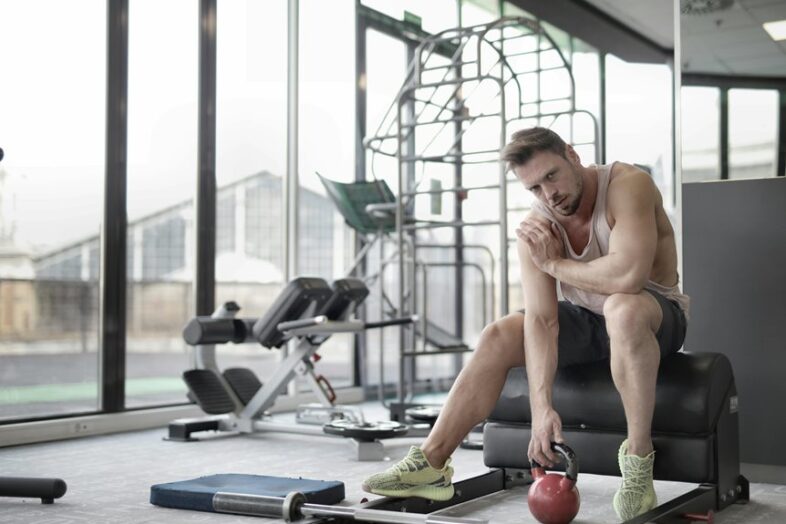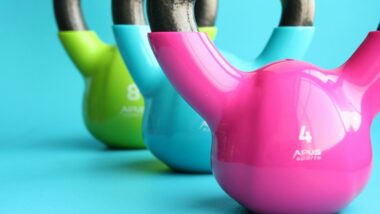A kettlebell leg workout circuit targets multiple muscle groups, including quadriceps, hamstrings, and gluteals. Exercises like goblet squats, Romanian deadlifts, and kettlebell swings engage the lower body and core. Proper posture and technique are vital for effectiveness and safety. This circuit improves hip mobility, strength, and power. By incorporating kettlebell exercises into a leg workout routine, individuals can experience significant benefits, and exploring the various exercises and techniques can help optimize the workout for specific fitness goals and preferences. Further exploration of these exercises can uncover even more ways to enhance lower body strength.
Key Takeaways
- Targets gluteus maximus and leg muscles.
- Improves lower body strength and power.
- Includes exercises like squats and deadlifts.
- Enhances functional fitness and athleticism.
- Boosts muscle growth and overall health.
Muscles Worked
As a thorough kettlebell leg workout targets multiple muscle groups, it is essential to understand the specific muscles worked to maximize the effectiveness of the exercise routine.
The primary muscle groups engaged in a kettlebell leg workout include the Gluteus Maximus, leg back, and core muscles. A squat, a fundamental movement in any leg workout, actively engages the Gluteus Maximus and requires lower body strength. Additionally, the movement demands engaging the core, which helps stabilize the body and maintain proper form.
The leg workout also indirectly targets the upper back, as it requires maintaining a straight posture throughout the exercise. Understanding the muscle groups worked during a kettlebell leg workout helps individuals belong to a community that values physical fitness and lower body strength.
Regular incorporation of kettlebell exercises, such as the kettlebell swing, can also lead to improved hip mobility and overall lower body strength, making it an effective addition to any workout routine.
The Workout
Focusing on the specifics of the kettlebell leg workout, the routine is comprised of several exercises that target various muscle groups, including the glutes, quadriceps, hamstrings, and calf muscles.
The kettlebell goblet squat and double kettlebell squat are integral to this routine, with the Sumo Squats variation also being utilized to target the hips and glutes. To execute these squats, it is essential to keep the hips back and maintain a parallel stance.
A Romanian Deadlift is also incorporated to target the hamstrings and hips, while kettlebell swings are used to increase power output and target the glutes. To perform these exercises effectively, it is vital to maintain proper form, including a neutral spine. By following this routine and focusing on proper technique, individuals can effectively target their leg muscles and achieve a sense of belonging among those who prioritize fitness and strength training. This workout is designed to be challenging yet accessible. Incorporating kettlebell exercises into a workout routine can help improve overall lower body strength and stability, and mastering proper form is crucial for effective and safe exercises.
Kettlebell Exercises
The kettlebell exercises outlined in this routine comprise an exhaustive set of movements designed to effectively target the major muscle groups of the legs.
These kettlebell exercises, including squats and Romanian deadlifts, are essential for building strength and endurance.
- Goblet squats work the quadriceps, hamstrings, and gluteals, while also engaging the core for improved stability and functional fitness.
- Romanian deadlifts target the hamstrings, hips, and middle/upper back, enhancing overall leg workouts and promoting core strength.
- The Walking Lunge targets the quadriceps, hamstrings, and gluteals, providing a thorough leg workout that improves balance and overall functional fitness.
Using kettlebells in these exercises adds a unique challenge, promoting increased strength and athleticism.
By incorporating these kettlebell exercises into a leg workout routine, individuals can experience significant gains in strength, power, and overall functional fitness, ultimately enhancing their belonging to a community of like-minded fitness enthusiasts.
Leg workouts with kettlebells offer a fun and engaging way to achieve fitness goals.
Incorporating kettlebell exercises into a workout routine can also improve cardiovascular health, leading to a more efficient and effective overall fitness regimen.
Training Considerations
When designing a kettlebell leg workout, load management is vital to avoid overexertion and prevent injury, requiring careful consideration of weight selection and progressive overload.
Rest time between sets and exercises also plays a significant role in determining the overall effectiveness of the workout, as adequate recovery allows for peak muscle growth and repair.
Effective management of these training variables – load management, rest time, and weight selection – is essential to guarantee a safe and productive kettlebell leg workout that yields desired results.
A well-structured workout routine should also incorporate the principles of muscle hypertrophy to maximize the benefits of kettlebell leg workouts and achieve optimal muscle development.
Load Management
Building on a foundation of proper technique, load management plays a critical role in progressing a kettlebell leg workout, as loading intensity and training volume must be carefully calibrated to align with the individual's strength and fitness level.
To build strength, individuals must work to stabilize their position when holding a kettlebell, allowing them to effectively load and unload the weight. Starting with lighter weights and gradually increasing the load enables individuals to build strength and confidence, eventually progressing to heavier kettlebells.
Some key considerations for load management include:
- Initial loading: starting with a weight that allows for proper technique and control
- Progressive overload: gradually increasing the load to continue making progress and avoiding plateaus
- Variable loading: incorporating different weights and resistance levels to challenge the muscles and prevent stagnation.
Effective load management is vital to guarantee a safe and effective workout, allowing individuals to belong to a community of like-minded individuals who value strength and fitness.
Rest Time
Effective management of rest time between sets is essential for maximizing the benefits of a kettlebell leg workout, as it allows for adequate recovery and muscle replenishment.
Rest time varies depending on the exercise, with the Standing Kettlebell Calf Raise requiring 45-60 seconds and the Kettlebell Swing needing 60 seconds.
To stay balanced and maintain proper muscle function, it's vital to keep your core engaged and focus on engaging your glutes, particularly when performing exercises that target the posterior chain, such as the Deficit Double Kettlebell Romanian Deadlift/Suitcase Deadlift.
This helps reduce less stress on the lower back.
Adequate rest time allows for muscle recovery, enabling you to stay balanced and focused throughout the workout.
Weight Selection
The weight of the kettlebell used in a leg workout circuit is a crucial consideration, as it directly impacts the effectiveness and safety of the exercise.
To guarantee a challenging yet safe workout, consider the following factors when selecting a kettlebell weight:
- Fitness level: Choose a weight that allows for completion of the given number of repetitions with proper form.
- Strength goals: Select a weight that is 25-35% of the individual's one-rep max for a given exercise.
- Training volume: Consider the overall intensity and volume of the workout routine to avoid overtraining and injury.
When selecting a kettlebell weight for a leg workout, it is critical to prioritize proper form and technique.
A suitable kettlebell weight allows individuals to complete the exercise with challenged strength, but still maintain control throughout the movement.
Benefits and Variations
Incorporating kettlebell exercises into a leg workout routine yields significant benefits, including added power and enhanced muscle growth.
The unique swing and lift motions involved in kettlebell training engage the legs in a distinct way, stimulating strength gains and improved athletic performance.
This type of training also promotes high intensity workouts, which can lead to increased calorie burn and improved cardiovascular health.
Added Power
How does one take their leg workout to the next level and release added power? Incorporating a kettlebell into your routine can be a game-changer.
A squat variation with a wide stance, focusing on hip extension and knee extension until thighs are parallel, can be highly effective. Using a single kettlebell or a pair of kettlebells can add an extra challenge to your workout.
To take your leg workout to the next level, consider the following:
- Alternating kettlebell squats: Switching between a single kettlebell and a pair of kettlebells to challenge your legs and core.
- Kettlebell split squats: Focusing on one leg at a time to improve balance and stability.
- Goblet squats with a kettlebell: Holding a kettlebell at your chest to engage your core and improve your squat form.
Muscle Growth
With regular practice and proper form, kettlebell leg workouts can stimulate significant muscle growth by challenging the quadriceps, hamstrings, gluteals, and calves through exercises like squats, lunges, and deadlifts. To achieve this, assume a squat position with your feet shoulder-width apart, bending your knees and keeping your hips forward. The unique weight and balance of the kettlebell put stress on the lower body, promoting muscle growth.
Kettlebell leg workouts, such as sumo squats and tactical lunges, can target specific muscle groups, enhancing overall lower body muscle growth. Incorporating kettlebell exercises into your routine can lead to increased muscle growth due to the explosive, hip-dominant nature of the movements. The kettlebell swing, for example, promotes muscle growth in the glutes and hamstrings.
Exercise Techniques
Proper exercise technique is crucial when performing kettlebell leg workouts, as it directly impacts the effectiveness of the exercises and helps prevent injuries. To achieve this, maintain a starting position with your feet shoulder-width apart and an upright posture. For exercises like the deficit double kettlebell Romanian deadlift, hold a kettlebell in each hand, keeping your chest up and core engaged.
When performing the kettlebell walking lunge, hold a kettlebell in each hand and focus on smooth shifts between the front leg and back leg. Keep the kettlebell close to your body and parallel to the ground to minimize strain.
Key techniques to focus on include:
- Maintaining proper posture throughout the exercise
- Keeping the kettlebell close to the body
- Engaging the core for stability and balance. By mastering these techniques, you can guarantee a safe and effective kettlebell leg workout that helps you achieve your fitness goals and feel a sense of belonging to a community of like-minded individuals.
Frequently Asked Questions
What Weight Kettlebell Is Recommended?
Choosing ideal weight kettlebells involves considering fitness standards, athletic benefits, and muscle gain, with options ranging from 8-32 kilograms, depending on exercise modifications and individual strength increases.
Can I Use Dumbbells Instead?
Quill in hand, considering Dumbbell difference as Kettlebell substitute, allows for Weight variation, enabling Exercise modification, minimizing Muscle impact, offering a Fitness alternative, as viable Training option and Workout substitute.
Is Warm-Up Necessary Beforehand?
Warm-up is vital for injury prevention, muscle activation, and blood circulation, enhancing physical preparation, mental focus, performance, flexibility, and energy, achieved through dynamic stretching exercises beforehand always.
How Often Should I Do Circuit?
Determining circuit frequency depends on individual fitness level, muscle growth goals, and workout plan, balancing strength training and physical conditioning to enhance athletic performance and muscle endurance ideally.
Can Beginners Start With Circuit?
Ironically, beginners often shy away, but circuit training is ideal for beginner workouts, promoting strength gains and muscle growth in a home gym, kickstarting a fitness journey with effective leg exercises.
Conclusion
Like a blacksmith shaping steel, the kettlebell leg workout circuit forges strength, much like Hephaestus crafting legendary armor, transforming legs into unyielding pillars, fortified through rigorous exercise and unrelenting dedication. This circuit is a proving ground, where athletes are tempered, emerging stronger, their resilience and power honed to perfection.


